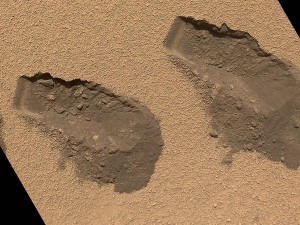NASA’s next Mars rover will advance hunt for past life

This picture provided by NASA on December 3, 2012, shows a view of the third (L) and fourth (R) trenches made by the 1.6-inch-wide scoop on NASA’s Mars rover Curiosity in October 2012. The next robotic rover to explore Mars in 2020 should scour the surface of the red planet more closely than ever for signs of past life, a NASA science team said Tuesday. AFP/NASA/HO
WASHINGTON—The next robotic rover to explore Mars in 2020 should scour the surface of the red planet more closely than ever for signs of past life, a NASA science team said Tuesday.
The US space agency’s science definition team (SDT) released a 154-page document containing its proposals for the next Mars rover, after five months of work.
The mission would use microscopic analysis for the first time, collect the first rock samples for possible return to Earth and test ways to use natural resources on site for a future human trip, it said.
The Mars 2020 mission would build on the work being done by NASA’s Curiosity rover, which has been exploring the red planet since August 2012 and has already found evidence of potentially habitable environments.
John Grunsfeld, NASA’s associate administrator for science, said the 2020 Mars rover would get the US space agency to the next step in the “quest to answer the grand questions,” before a planned human mission in the 2030s.
Article continues after this advertisement“Do we see any evidence of past life in those habitable environments?” he said.
Article continues after this advertisementThe next step is for NASA to analyze the recommendations and issue a call for scientific instruments, which could include higher resolution imaging devices, microscopes, fine scale minerology, chemistry and organic carbon detection tools.
“To combine this suite of instruments would be incredibly powerful,” said Jack Mustard, SDT chair and professor of geological sciences at Brown University.
The rover would collect about 31 samples that might someday be returned to Earth, representing “a legacy for understanding the development of habitability on the planet,” he told reporters.
The US space agency has not yet devised the technology to bring the cache back to Earth without disturbing its contents, and no plans have been set for any potential sample-return.
The next NASA mission to Mars is a November launch of MAVEN, an orbiter that will study how Mars interacted with the solar wind and lost its atmosphere.
The European Space Agency will follow in 2018 with its ExoMars rover.
“The Mars 2020 mission will provide a unique capability to address the major questions of habitability and life in the solar system,” said Jim Green, director of the Planetary Science Division at NASA headquarters, describing the plans as “a major step toward seeking signs of life.”
The rover would explore an ancient site on Mars, which has yet to be decided, and any samples it collects may help reveal hazards posed by Martian dust to potential human explorers.
However, samples would have to “be retrieved, potentially quarantined, and preserved in such a way that potential hazards are identified and mitigated,” NASA said.
Research toward that goal is complicated but worthwhile since robotic analysis cannot “match the depth and sensitivity of analysis that can be done on samples in Earth laboratories,” NASA said.
NASA also said the rover could demonstrate how to collect carbon dioxide, which could be used as a resource for making oxygen and rocket fuel for astronauts who land on the surface.
If NASA accepts the SDT’s recommendations, the 2020 mission would “examine wether past environmental conditions were favorable to have supported microbial life, and also… for preserving clues about life, if any existed,” NASA said.
“Beyond that, it would check at a microscopic level for potential visual, mineralogical and chemical signs of past life.”
The design would be based on the Curiosity rover, a $2.5 billion dollar project that launched toward Mars in 2011, and would use the same elaborate rocket powered sky crane for landing.
Re-using the past plans, along with some spare parts left over from the building of Curiosity, would help keep mission costs and risk “as low as possible,” the space agency said.
Advances in technology may lead to an even more precise landing system than last August’s entry, landing and descent process that was coined “Seven Minutes of Terror” by NASA.—Kerry Sheridan